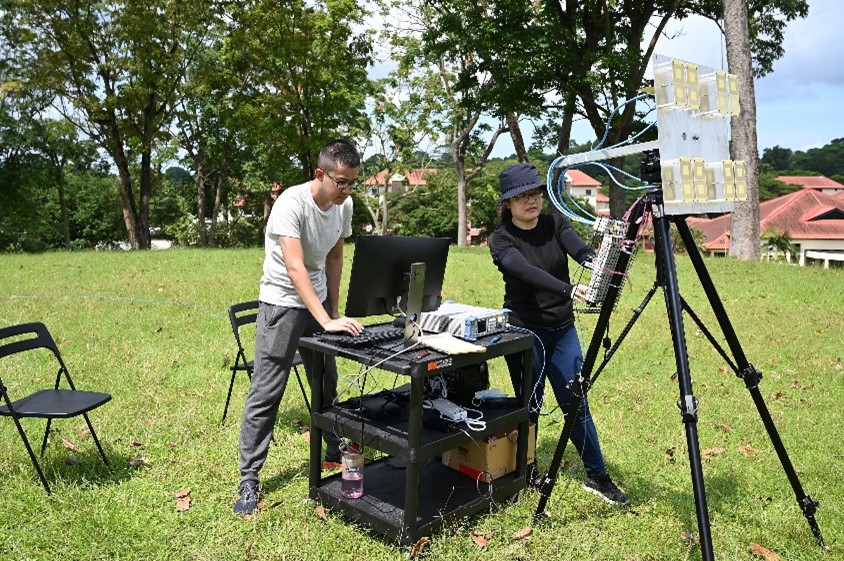Center for Communication and Signal Processing



Our projects include the development of an RF antenna and receiver array that is capable of pinpointing the location of wireless transmit sources in a building. The hardware is fitted with our developed algorithms. Our researchers set up and perform actual field trials to validate and refine the performance of the developed prototype.
Find out more about the different areas below:

Sensor Array
The Sensor Array Research Programme aims to provide relevant and advanced sensor array processing technologies to the Singapore defense community. The scope of research extends from the physics of signal processes and sensors, through mathematical formulations and algorithm developments, to implementation and experimental investigations. To accelerate the technology developments, the team collaborates extensively and across traditional boundaries between disciplines. The current research focuses are:
- Robust radio frequency (RF) Array Processing
- Algorithms that are robust to uncertainties about the sensors and the signal processes.
- Robust RF Geolocation and Tracking Methods
- Advanced RF emitter localization and tracking methods in urban environments.
- Advanced Front-End Signal Processing
- SubNyquist sampling methods and processing.
- Advanced methods to improve the limitations in analogue front-end and sensors.
- Automated RF Signal Characterization
- To develop signal processing methods to characterize, analyse, compactly represent and classify communication signals.
- Machine Learning for Signal Processing
- To develop novel machine learning algorithms for RF communications and array signal processing

Signal Processing Systems
Led by Dr Lee Jun Wei
The team aim to provide advanced expertise in the area of digital signal processing with particular focus towards end-to-end research, development, integration and prototyping. The team specialize in bringing digital signal processing concepts to practical realizations in resource-constrained systems. Our scope ranges from:
- real-time field-programmable gate array (FPGA) signal processing,
- developing signal processing systems for performance characterization and measurements,
- architecture and implementation-specific optimization for improved footprint, power consumption and processing speed,
- analog to digital conversion (ADC) and digital to analog conversion (DAC) systems,
- research in general and specialized digital signal processing.
Recent highlights include:
- Robust, interference-resistant high-dynamic range receiver design that is capable of signal reception in the presence of very high-powered interference signals.
- Real-time very-high-speed filter, filter bank, adaptive filter, sampling-rate converter design and implementation in Xilinx FPGA.
- Real-time processing of compressed very-large bandwidth data in a sub-Nyquist photonic receiver, using National Instruments FPGA systems.
- ADC and DAC system enhancements using time-interleaving, non-linearity and spurious frequency compensation.

Urban Sensing
Led by Dr Sirajudeen s/o Gulam Razul
As our terrain becomes increasingly built-up, it is important for urban operations such as in law enforcement to be able to quickly traverse an urban corridor, determine the internal structures behind walls and sense human activity inside the buildings. This research programme aims to study:
- Advanced techniques for urban sensing, particularly in detecting, enumerating and localizing humans inside the building, classifying their activity and inferring their intentions.
- Advanced techniques for sensor self-localization in urban canyons and indoor environments.
To achieve this goal, the team will exploit the abundant signals-of-opportunity (SoOP) such as WiFi, Long-Term Evolution (LTE) and available personal communication devices as well as optimized waveforms generated in the Industrial, Scientific, and Medical (ISM) frequency bands by sensors to develop advanced techniques of combining both active and passive electromagnetic sensors under the concept of network-centric operations.

Signal Research
Led By Prof Guan Yong Liang
The Signal Research Program focuses on receiver signal processing, detection and decoding of communication signals in practical wireless channels. The team strive to build intelligent, high-performance wireless receivers capable of recovering speech and data transmitted under practical channel effects and challenging system constraints.
Our competence areas include joint channel tracking and signal equalization in fast multi-path channels, blind synchronization (time, frequency, oversampling ratio), receivers for short-burst communication and impulsive noise channels, Turbo (iterative) receivers with reduced complexity, multi-antenna communication techniques, soft decoders for error correction, signal recovery in blind multi-user interference channels, etc. Our facilities and resources include software re-configurable radios, communication and speech codecs, and related software modules.
The team has achieved the following:
- A patent on a method to perform pilot-aided channel estimation (CE) and equalization for high-rate communication over fast fading multipath channel without excessive pilot insertion.
- A multi-user detection algorithm which blindly separates multiple communication signals that interfere in both time and frequency domains.
- An effective turbo equalizer (TEQ) that demodulates single-carrier transmission over multipath channels corrupted by impulse noise. Compared to the conventional Gaussian-noise equalizers, the proposed TEQ provides a gain of up to 4.5dB.
- A set of new training waveforms for use by constant-envelope communication systems such as continuous phase modulation (CPM) system. The training waveform is scalable in length and has auto-correlation property that is near perfect.
- A method of recovering erased data packets in a lossy multi-hop network, achieved by space-time network coding. This network code is an improvement over the state of the art, and its performance meets the theoretical upper bound.

